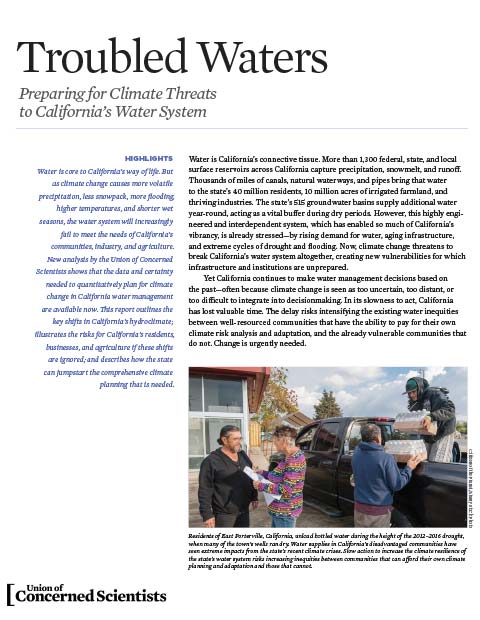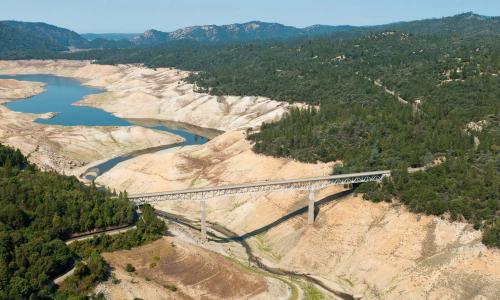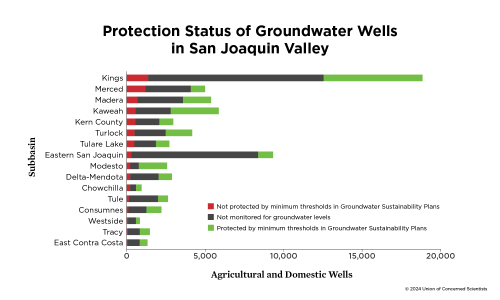Water is core to California’s way of life.
But as climate change causes more volatile precipitation, less snowpack, more flooding, higher temperatures, and shorter wet seasons, the water system will increasingly fail to meet the needs of California’s communities, industry, and agriculture.
New analysis by the Union of Concerned Scientists shows that the data and certainty needed to quantitatively plan for climate change in California water management are available now.
This report outlines the key shifts in California’s hydroclimate; illustrates the risks for California’s residents, businesses, and agriculture if these shifts are ignored; and describes how the state can jumpstart the comprehensive climate planning that is needed.
Troubled Waters
This is a condensed, online version of the report. Access to all figures and full report are available through download of the PDF.
Water is California’s connective tissue. More than 1,300 federal, state, and local surface reservoirs across California capture precipitation, snowmelt, and runoff. Thousands of miles of canals, natural waterways, and pipes bring that water to the state’s 40 million residents, 10 million acres of irrigated farmland, and thriving industries. The state’s 515 groundwater basins supply additional water year-round, acting as a vital buffer during dry periods. However, this highly engineered and interdependent system, which has enabled so much of California’s vibrancy, is already stressed—by rising demand for water, aging infrastructure, and extreme cycles of drought and flooding. Now, climate change threatens to break California’s water system altogether, creating new vulnerabilities for which infrastructure and institutions are unprepared.
Yet California continues to make water management decisions based on the past—often because climate change is seen as too uncertain, too distant, or too difficult to integrate into decision-making. In its slowness to act, California has lost valuable time. The delay risks intensifying the existing water inequities between well-resourced communities that have the ability to pay for their own climate risk analysis and adaptation, and the already vulnerable communities that do not. Change is urgently needed.
New analysis by the Union of Concerned Scientists (UCS) and its collaborators demonstrates that climate change is transforming how, when, and where California gets water—its hydroclimate—changes that can be measured with enough certainty to enable strategic climate and water planning (Persad et al. 2020) (Figure 1). This analysis highlights several critical challenges that climate change will create for California’s water management within this century, what they mean for managing the state’s water, and how the state and water management community can respond:
-
Climate change will transform key aspects of how, when, and where California gets its water. Precipitation will arrive increasingly as rain rather than snow, occur in more intense events, and be concentrated into the already wet winter months. Volatility between overall dry and wet water years will increase. Snowpack will decline dramatically
-
Climate change projections agree on a range of critical shifts that need to be accounted for in all California water decisionmaking. Climate change datasets developed for the state climate assessment show almost universal agreement on these transformations in California’s water. But most federal, state, and local water planning does not account for this critical information.
-
State agencies and water managers are underprepared for the water management challenges of California’s altered hydroclimate. The projected impacts of climate change are likely to damage the viability and sustainability of California’s surface reservoirs and increase demands on its groundwater aquifers. Water planning based on historical conditions misses these critical impacts. If water planning continues to fail to account for the full range of likely climate impacts, California risks wasted water investments, unmet sustainability goals, and increased water supply shortfalls.
-
Ensuring the resilience of communities in the face of California’s new hydroclimate will require transformational, but achievable, change in approaches to water management and decisionmaking. The state’s altered hydroclimate will require California to become more flexible in how it uses and manages water. The climate data and water management expert communities need to become regular collaborators, working together to develop new planning protocols and operations models able to take all future climate-changed conditions into account. State and local water regulations, including the landmark 2014 Sustainable Groundwater Management Act, need to be updated to require comprehensive climate planning.
California’s Water System Is Unprepared for Climate Change
California’s water system is engineered around assumptions that are being fundamentally altered by climate change. Infrastructure for the state’s surface water has been optimized to capture springtime melt of mountain snow-pack, which historically has served as a natural wintertime reservoir, and to deliver that water through an extensive net-work of natural and constructed waterways to meet human and ecosystem demand through the drier summer and fall. This same infrastructure has also been tasked with flood protection during periods of intense rainfall or snowmelt runoff by storing, releasing, and diverting water to minimize damages. The state’s groundwater aquifers have provided the remainder (or, for some regions, all) of the water supply and have historically served as a buffer during periods of surface water scarcity (Christian-Smith 2015).
But climate change is transforming California’s hydro-climate in ways that strain or overwhelm this infrastructure as designed. Since the 1950s, average annual temperatures in California have increased by more than 1°F (Bedsworth et al. 2018), water stored in springtime snowpack has declined by 10 percent (Mote et al. 2018), and the relative amount of snow versus rain in the winter has dropped (Knowles, Dettinger, and Cayan 2006), jeopardizing the natural snowpack res-ervoir as a reliable form of storage. Due to climate change, drought risk in California now is twice as high as over the previous 100 years (Diffenbaugh, Swain, and Touma 2015), amplifying stress on the state’s groundwater reserves, and the frequency of both wet and dry extremes is increasing (Swain et al. 2018). These changes are all undermining the long-term functionality of the state’s century-old water infrastructure.
The impact of these shifts on California’s water resources has been starkly illustrated over the last several years of drought and flood. During the 2012–2016 drought, as surface water availability collapsed and snowpack dropped to record lows, increased groundwater pumping supplied 70 percent of agricultural water use (Lund et al. 2018). That overreliance on groundwater accelerated critical drawdown of aquifers, damage to infrastructure as the land over depleted aquifers sank, and catastrophic—and, in many places, still ongoing—loss of water supply to rural communities as wells went dry (Langridge et al. 2018). These impacts helped galvanize passage of the 2014 Sustainable Groundwater Management Act (SGMA), which requires more than 100 overdrafted groundwater basins in the state to undergo extensive planning and action to achieve sustainable groundwater use over the next two decades.
Meanwhile, the record-setting wet years that followed the drought served as a prime example of the risks associated with too much water arriving in forms the infrastructure is ill-equipped to manage. Although the state’s snowpack and surface reservoirs experienced two years of near- or above-average storage in 2017 and 2018, the extreme precipitation also contributed to the failure of the Oroville Reservoir spill-way and the evacuation of almost 200,000 residents down-stream (White et al. 2018). Even as the excessive precipitation caused significant damage to infrastructure and communities, it did not substantially replenish the state’s key groundwater reservoirs (Bedsworth et al. 2018).
However, despite the water challenges the state has already seen, California continues to fall short on making its water supply resilient to climate change. There are currently no state-level operations models capable of accounting for many of the critical climate shifts projected for California by climate models (Knowles et al. 2018), and many water decisions in the state are made based on historical assump-tions that increasingly fail to apply. For example, the rules that currently dictate when the state’s surface reservoirs must store or release water to protect against flood are based on assumptions about the timing and intensity of reser-voir inflows that date from decades before the dams were built—more than 60 years ago for many of California’s largest reservoirs (Belin 2018; Eum, Vasan, and Simonovic 2012). These outdated rules created additional storage and supply problems during the record-breaking 2012–2016 drought by requiring wintertime release of water that could have been stored (Revelle 2014). Where climate change planning is included in water decisions, it is generally extremely limited. Even the recently enacted SGMA regulations only suggest that local agencies consider certain time-averaged climate shifts in their projected groundwater budget. The regulations do not require planning for climate extremes or consideration of cli-mate change in the design of any groundwater sustainability actions or projects the agencies propose. Agencies therefore run the risk of investing in projects that will not stand the test of future conditions or of underplanning and underadapting for increased future stress on their groundwater sustainability.
This slow action at the state level risks intensifying cli-mate adaptation inequities between well-resourced regional water agencies—which often have the revenue to generate their own comprehensive climate data and to buffer their water supplies against climate impacts—and vulnerable and under-resourced communities that must rely on the state to provide sufficient climate data, guidance, and adaptive capacity. The Los Angeles Metropolitan Water District and San Francisco Public Utilities Commission, for example, have partnered with universities and private research enterprises to conduct sophisticated climate risk analyses and produce comprehensive climate adaptation strategies for their water resources (Groves et al. 2015; Park et al. 2019). Meanwhile, agencies in some rural groundwater basins—more than half a million of whose residents remained without access to clean and affordable drinking water following the 2012–2016 drought (Feinstein 2018)—have struggled to include climate change data in their groundwater sustainability planning, even to the limited extent required by the SGMA (Christian-Smith et al. 2017; IWVGA 2020).
Critical Climate Shifts for California’s Water: We Know Enough to Act Now
Projections of what climate change has in store for California’s hydroclimate, based on the output of global climate models, have been available for decades. But much of water management has focused on what these projections say about quantity—whether California will get more or less total precipitation, which has remained uncertain (Bedsworth et al. 2018; Schwarz et al. 2018). Even with the most severe pro-jected path of climate change, different climate models show that California could get more or less total precipitation, and climate models on average suggest that the state could get the same or slightly more total precipitation in the future (Persad et al. 2020). This has led to a false perception that the impacts of climate change on California’s water resources are either too uncertain or too minor to warrant universal inclusion in water planning. However, as the present analysis and a growing body of other scientific work shows, climate change has much more in store for California’s water than changes in total or average precipitation. Crucially, climate change data-sets agree almost universally on intensification of a range of shifts—more frequent extreme events, more precipitation falling as rain and less as snow, declining snowpack, rapid drying of soils and crops—that are already creating new, troubling, and predictable stress for the state’s water resources. Federal, state, and local water decisionmakers across California must start planning for these shifts now. Readily available data and analysis can be their guide.
UCS-led analysis, described more fully in Persad et al. (2020), lays bare the range and magnitude of climate shifts currently projected for the state of California and shows that these shifts can be expected with high certainty. The research looked at the suite of climate model datasets developed for the Fourth California Climate Assessment (Bedsworth et al. 2018) and widely used across state climate planning and guid-ance documentation (DWR and CCTAG 2015; SGMP 2018). It defined and calculated a range of climate changes in how, when, and where California gets water and identified how well the suite of model datasets agree (see the table).
The research analyzed data from two scenarios used by the state, which project two options for how severe and rapid the trajectory of climate change could be depending on society’s emissions choices. The maps and values shown here are for the more severe of the two scenarios, but even with a slower rate of climate change, the trajectory and high certainty shown here still apply (Persad et al. 2020). The projected changes have profound implications for on-the-ground water supply outcomes.
The climate projections agree on the following shifts by the end of the century with severe climate change:
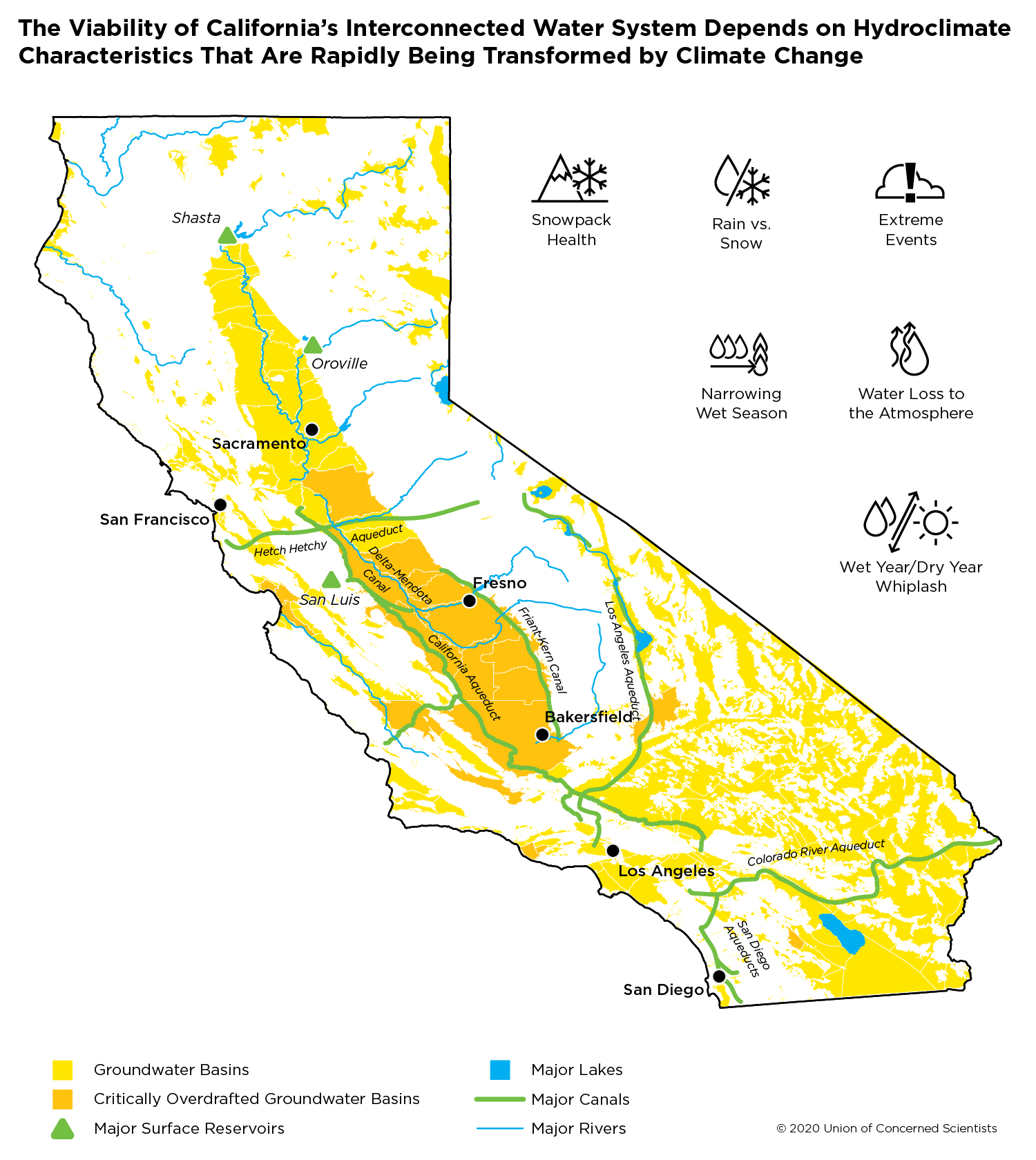
- Snowpack health declines. The ratio of rainfall to snow-fall is projected to increase statewide and almost double in the high Sierra, with almost complete snowpack loss at lower elevations statewide (Figure 2). This essentially eliminates the natural snowpack reservoir as a reliable form of storage. In addition, the risk of rain-on-snow events that cause rapid snowmelt and flooding increases wherever snowpack remains (see table), jeopardizing the water supply benefits of healthy snowpack years
- Precipitation becomes more extreme. The proportion of yearly precipitation that arrives in the most extreme events is projected to increase by more than 15 percent across central California (Figure 3). Extreme events become more intense statewide (see table), in certain places by 40 to 50 percent (Persad et al. 2020). These types of events increase the risk of floods and mudslides and make precipitation harder to store and manage.
- The wet and dry seasons intensify. The proportion of yearly precipitation that falls in the already wet winter months is projected to increase statewide by 5 to 6 per-cent (Figure 3) and by up to 20 percent in certain places (Persad et al. 2020). This requires greater water storage in a shorter timespan and creates a longer and more intense dry season when stored supplies must meet demand.
- Swings between extreme years increase. The likelihood of very wet and very dry years is projected to increase, doubling or tripling in parts of the state (Persad et al. 2020), resulting in a higher likelihood of swings between very wet and very dry years and increased overall volatility of year-to-year precipitation (see table). Similar volatility following the 2012–2016 drought contributed to fatal mudslides, unexpected wildfire behavior, and damage to water infrastructure.
The high level of model agreement holds across both climate change scenarios used by the state, but the magnitude of impacts and how quickly they manifest could be reduced with serious additional worldwide commitments to reduce heat-trapping emissions.
What Are the Risks of Failing to Plan for Climate Impacts on California’s Water?
Taken together, these results demonstrate strong consen-sus—even without substantial or high certainty changes in California’s total annual precipitation—that water will come in fundamentally different forms for which California’s infra-structure operations, water allocation processes, and long-term water investment planning are ill-prepared. The state has not yet developed sufficient alternatives to its current reliance on the combination of snowpack, surface reservoirs, and conveyance, which will be unsustainable as climate change makes snowpack increasingly unreliable. Federal, state, and local water entities are not yet capable of utilizing the huge amounts of rainwater that will arrive within more extreme multiday events and in a narrower seasonal window, arriving at times when it is neither needed nor currently able to be stored. Flood systems are not yet prepared to manage the increased risk of rain-on-snow events in years when California does have snowpack or to make use of water from those events to maintain water supply benefits in the increas-ingly rare years of healthy snowpack.
In short, without changes in water management strategies, the current system will be less able to capture and utilize the available water in the new forms in which it will be delivered.
Even statewide assessments that only account for a subset of these shifts forecast major performance declines on California’s State Water Project and Central Valley Project including: less water available at the start of the irrigation season; less stored water left over from year to year, and therefore less drought resilience; more water needed to meet environmental requirements such as water level and temperature needs of native and protected fish species; and decreased deliveries to water contractors that supply millions of California water users (Schwarz et al. 2018; Wang et al. 2018). Much of this is driven by the reality that surface reservoirs and the rules governing their operation will be ill-equipped to manage and store the concentrated flows that climate change has in store (Box 1).
It is increasingly clear that making use of the state’s massive groundwater aquifer capacity will be key to achieving the greater and more flexible storage that these climate shifts will require (CNRA, CEPA, and CDFA 2020; Christian-Smith 2015). To recharge groundwater aquifers at scale, however, will require the capacity to move water from where it falls to where it can be stored underground and eventually to where it is needed, a water rights system that allows for this flexible use, and investment in research and monitoring to find the best sites and prevent negative water quality impacts—as currently being pursued under the state’s Flood-MAR (Flood Managed Aquifer Recharge) program (CDWR 2018).
Importantly, as groundwater plays an increasingly large role in supplying flexible water storage and supply, climate change will need to be quantitatively and comprehensively integrated into groundwater planning in ways that it cur-rently is not, in order for this crucial resource to be sustain-ably managed as conditions change (Box 2). Notably, however, few groundwater agencies use hydrologic models to set and evaluate their groundwater sustainability plans that can be accessed and independently tested by stakeholders, research-ers, or even potentially the regulating agencies—relying instead on proprietary models whose climate assumptions are often under-described and untestable (Christian-Smith et al. 2017). But comprehensive climate planning is crucial. UCS-led analysis shows that even a single climate shift can meaningfully affect the relatively unstressed Scott Valley basin’s groundwater sustainability (Persad et al. 2020; Box 2). Multiple climate shifts will likely bring much greater impacts. If the massive efforts undertaken as part of the landmark SGMA regulations are to provide benefits in a climate-changed future, local groundwater agencies will need to plan for the impacts of all climate change shifts both in their overall groundwater budgets and in individual management actions and projects.
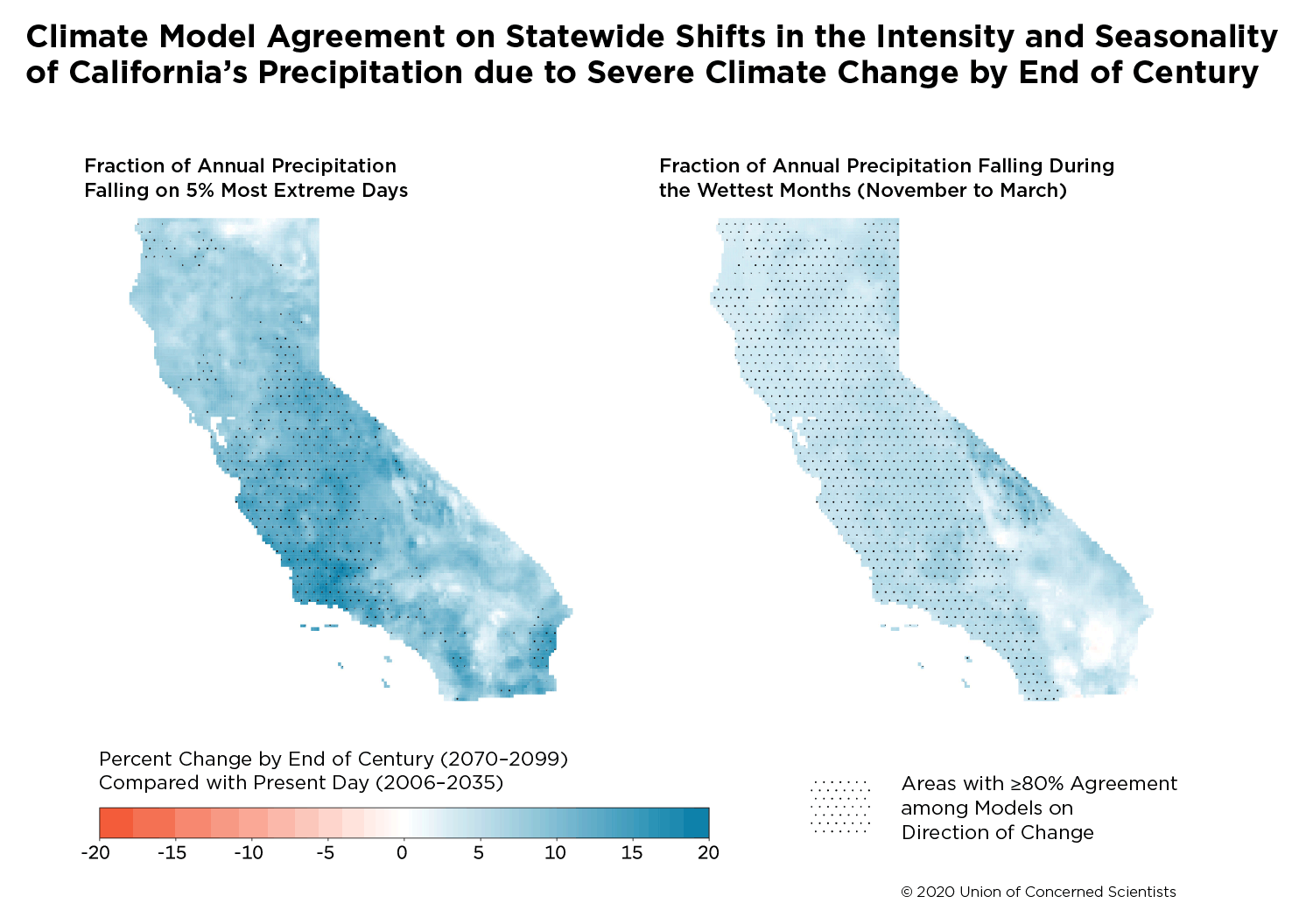
precipitation into the most extreme days and into the already wet winter months, as well as nine other critical shifts in how, when, and where
California gets its water.
Note: Changes are shown for end-of-century average conditions (2070–2099) compared with present-day average conditions (2006–2035) under the more
severe of two available climate change scenarios.
Recommendations for a Climate-Prepared California Water Future
The data and certainty needed to quantitatively plan for climate change in California water management are available now. These high-probability shifts in how, when, and where California will get precipitation in the future demonstrate both the critical importance of an overhaul of California’s water system and the necessity and feasibility of including quantitative climate planning in all water decisions.
This transformation of California’s hydroclimate means that the past cannot be used to plan for the future—more of the same will not achieve long-term resilience for California’s water. A more flexible water storage system is needed, capable of handling the arrival of large volumes of water in short amounts of time. This will require innovative strategies, including increased use of the state’s groundwater aquifers to store excess flows from overtaxed reservoirs or banking stormwater captured during extreme events. In addition, the state’s existing infrastructure of surface reservoirs and conveyance will need to be more dynamically operated to accommodate the increasing volatility of precipitation and to enable optimal use of water as it increasingly arrives in these inconvenient forms.
Prioritizing and effectively implementing these solutions will require that comprehensive, quantitative, and up-to-date climate planning become universal in California water management. Several steps can and should be taken across federal, state, and local water decisionmaking to achieve this:
-
State and local water planning processes and tools should be updated to capture all projected hydroclimate shifts. State agencies and practitioner communities (for example, academics, state and local agency staff, and consultants) should develop and deploy hydrologic and operations models that can represent the effects of allclimate shifts on California water management, including shifts in short-term precipitation extremes. The state should utilize these tools to require and facilitate the integration of quantitative climate planning into all aspects of state water management.
-
Federal, state, and local water decisionmakers should work together to ensure consistency in their use of data and analysis around climate change. California’s water supply is dependent on decisions made at multiple levels of governance and between many overlapping jurisdictions. All of these interacting water decisions will need to be based on consistent assumptions and data on climate impacts and climate risk to prevent unanticipated mismatches in climate planning and adaptation. This will require the sharing of what is now proprietary data in some instances. It will also require greater clarity on what hydroclimate changes government planning tools do and do not account for, so that managers can under-stand what additional risks they may need to plan for.
-
Crucial water sustainability regulations, such as the SGMA, should be updated to require and support stronger climate planning. Sustainable groundwater will be the backbone of a climate-resilient water system for California. The SGMA provides a key opportunity to get the state on the right track, but it is not currently structured to ensure that the plans will stand the test of climate change (Christian-Smith et al. 2017). SGMA regulations and guidance should be updated to require local agencies to quantitatively: (1) assess the impacts of all climate shifts on the long-term sustainability of their water budgets, and (2) account for climate change in the design of all projects and management actions proposed to achieve groundwater sustainability. State agencies should also establish working groups, advisory commit-tees, and technical assistance teams as needed to provide the guidance necessary to support local agencies’ ability to do this. Similar requirements and support should be put in place for siting of and investment in all water infrastructure.
-
Processes and platforms should be created to increase two-way collaboration and interaction between climate scientists and water managers so that climate data and analysis can be optimized for use in water decisionmaking. The depth and type of climate analysis conducted in any water planning process need to be tailored to the particular climate vulnerabilities and risk tolerance of the project or decision at hand. This will require the producers of climate projection data to understand the needs of water managers so that they can generate optimally usable data, and for water managers to understand the opportunities, limitations, and best practices in applying climate projection data. Scientific initiatives like the multi-institutional HyperFACETS (formerly Hyperion) project provide a template for how increased engagement between climate scientists and water managers can be funded and structured. Agency initiatives such as the California Climate Change Technical Advisory Group provide successful examples of expert input that should be widely emulated across state agencies and made a permanent part of state decision support (DWR and CCTAG 2015).
As climate change causes more volatile precipitation, less snowpack, more flooding, higher temperatures, and shorter wet seasons, the water system will increasingly fail to meet the needs of California’s communities, industry, and agriculture. Without major shifts in planning and investment, it will be unable to capture and store enough water to meet demand. Federal, state, and local water managers must account for future climate-changed conditions in all of their water decisions, and California must become more flexible in how it manages water. Crucially, without strong climate change planning, the water system will be even less able to meet the needs of California’s most vulnerable communities, who were the first to bear the burden of past water system challenges. But by making quantitative, comprehensive climate change planning a cornerstone of water management, California has an opportunity now to create a smart and resilient water future for all.
This is a condensed, online version of the report. Access to all figures and full report are available through download of the PDF.
Downloads
Citation
Persad, Geeta, Jose Pablo Ortiz Partida, Daniel Swain. 2020. Troubled Waters: Preparing for Climate Threats to California’s Water System. Cambridge, MA: Union of Concerned Scientists. Troubled Waters.
